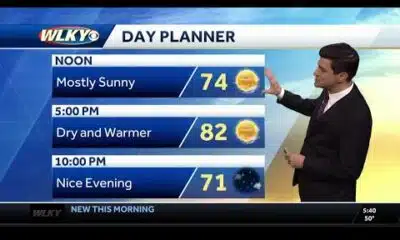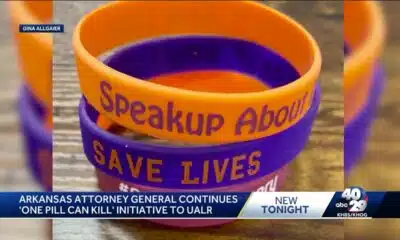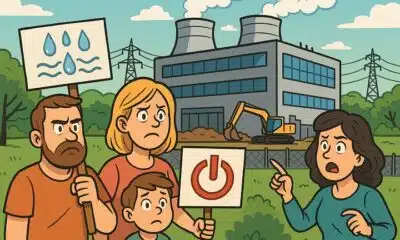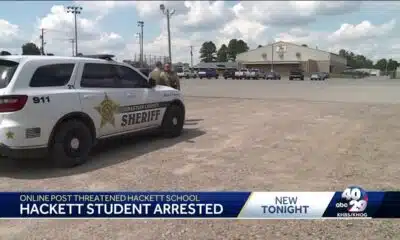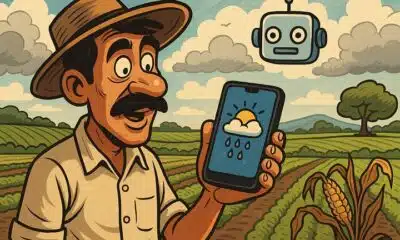News from the South - Kentucky News Feed
Powerball lottery players in Missouri and Texas to split nearly $1.8 billion jackpot
SUMMARY: Powerball players in Missouri and Texas won a $1.787 billion jackpot on Saturday, ending a three-month drought without a big winner. The winning numbers were 11, 23, 44, 61, 62, and Powerball 17. The Texas winning ticket was sold at a gas station in Fredericksburg. This prize is the second-largest U.S. lottery jackpot ever, following 41 drawings with no jackpot winner since May 31. Odds of winning are 1 in 292.2 million. Winners can choose between an annuity of $893.5 million paid over 30 years or a lump sum of $410.3 million, both before taxes.
Read the full article
The post Powerball lottery players in Missouri and Texas to split nearly $1.8 billion jackpot appeared first on www.wnky.com
News from the South - Kentucky News Feed
Warming up: Highs in the 80s return with hotter days ahead
SUMMARY: Temperatures are warming up with highs returning to the 80s and trending hotter in the coming days. Morning lows and afternoon highs will rise steadily, with dry conditions expected to persist through the week and possibly longer. Despite recent rain, yards and gardens are drying out. Today’s highs near 82°F, about five degrees warmer than yesterday, with low humidity and mostly sunny skies. Wednesday will be calm and dry with highs around 85°F. By the weekend, summer heat returns with highs near 90°F, continuing into next week with temperatures reaching the low 90s and above-normal warmth across much of the U.S.
WLKY Meteorologist Matt Milosevich has the latest on a warming trend that will have us feeling very summerlike by the weekend.
Subscribe to WLKY on YouTube now for more: http://bit.ly/1e5KyMO
Get more Louisville news: http://www.wlky.com
Like us: http://www.facebook.com/wlkynews
Follow us: http://twitter.com/WLKY
Instagram: https://www.instagram.com/wlky/
News from the South - Kentucky News Feed
KY public school advocates want $718 million ‘investment,’ but Republicans are skeptical
SUMMARY: Public education advocates in Kentucky, led by the coalition Protect Our Schools, are urging the General Assembly to invest an additional $718 million in K-12 education in the upcoming two-year budget. This amount equals a previously approved half-percent income tax cut. The investment would increase SEEK funding by 14%, fully fund transportation, and support resources like textbooks and technology. Superintendent Carrie Ballinger emphasized that this is a wise investment in Kentucky’s future workforce. However, Republican lawmakers, including Senate Education Committee Chair Steve West and House Speaker David Osborne, remain skeptical, citing record funding levels and budget conservatism amid concerns over education spending efficiency.
Read the full article
The post KY public school advocates want $718 million ‘investment,’ but Republicans are skeptical appeared first on lexingtonky.news
News from the South - Kentucky News Feed
Deer farm herd killed to stem spread of ‘zombie’ deer disease in Kentucky. Now what?
by Liam Niemeyer, Kentucky Lantern
September 8, 2025
A disease outbreak on a Kentucky deer farm is renewing questions about whether stronger rules are needed for the more than 100 “captive cervid facilities” the state has permitted.
State and federal agencies recently confirmed eight cases of chronic wasting disease (CWD) at a deer farm in Breckinridge County where the illness had first been detected in a single deer in October 2024.
Chronic wasting disease is a fatal prion disorder similar to mad cow disease. Only 10 cases have been confirmed in Kentucky — nine of them on the Breckinridge County farm — out of 40,000 tests since 2002. But the disease’s spread in other states has made preventing it a priority for wildlife managers nationwide because it causes population declines in deer and elk when prevalent.
Much about the neurological condition — dubbed “zombie deer disease” — is unknown. In deer, it causes significant weight loss, listlessness and death. A deer can appear healthy and have CWD for months or years before symptoms appear. Research has produced conflicting conclusions on the risk of it spreading to humans.
In Breckinridge County, more than 100 captive deer were killed in early July at Sinking Creek Whitetails, said co-owner Laura Voyles, whose family started the deer farm in 2020. A Kentucky Department of Agriculture statement said the “depopulation was carried out” at the request of the owner “to protect animal health and prevent further spread. KDA’s role was to collect the necessary samples and submit them to the lab for testing.”
Several state and federal agencies were involved, the state ag department said.
Voyles said the farm’s only other option would have been to quarantine the deer for years and hope no further cases appeared. She said the farm kept the deer alive and quarantined for months until the agencies “got their ducks in a row enough to come massacre them.”
“It’s just devastating to know that what you have poured your life into, from just a blood, sweat and tears perspective, in addition to all of the finances that had been poured into it was just gone in a moment,” Voyles said.
Voyles said the initial chronic wasting disease case found last year came from a healthy-appearing female deer, purchased from outside her farm, that was harvested for meat and subsequently tested. She said she was skeptical of the positive test results because the Kentucky Department of Agriculture “refused” to allow for third-party testing. A Kentucky Department of Agriculture spokesperson said it had “full confidence” in the testing done at the “nation’s premier facility for livestock disease testing”, the U.S. Department of Agriculture’s National Veterinary Services Laboratories in Iowa.
After the first diseased deer was discovered at Voyles’ farm last fall, Kentucky Department of Fish and Wildlife Resources officials responded by putting Breckenridge County and adjoining Meade and Hardin counties into a surveillance zone in an effort to block spread of the disease. Hunters who take deer in those three counties are required to have the animals tested for chronic wasting disease, and only specific parts — deboned meat, a clean skull with no brain tissue, cleaned teeth, hides, antlers and finished taxidermy mounts — can be taken out of the surveillance zone.
The only other confirmed chronic wasting disease in Kentucky was an isolated case discovered in 2023 in a wild deer in Ballard County.
A bill stalls to add deer farm regulations
Earlier this year, legislation was introduced in Frankfort aimed at containing the disease. The bill died after opposition from a vocal deer farming industry that views deer as a form of agriculture and an income source.
Kentucky Department of Fish and Wildlife Resources Commissioner Rich Storm told lawmakers that the measure was “critically important” to protect not only the state’s deer population but also the elk herd that has rebounded in Eastern Kentucky. He said tourism generated by hunting brings in billions of dollars every year.
The bill, sponsored by Rep. Josh Bray, R-Mount Vernon, would have expanded the radius of a surveillance zone when chronic wasting disease is detected in a wild deer or on a deer farm. It also would have halted the transfer of captive deer within and from areas where a case is found on a deer farm. Deer farms could have been exempted from the restrictions by surrounding themselves with a second fence to prevent wild deer from interacting with captive deer. The bill advanced out of a committee but didn’t receive a vote by the Kentucky House of Representatives.
One of the main ways deer farms make money is by selling deer with desirable genetics, such as large antlers, to private preserves for people to hunt and to other deer farms. A desirable buck may sell for thousands of dollars.
Jason Becker, president of the Kentucky Alternative Livestock Association that represents deer farmers, disputes the need for new limits on deer farms. “Most concerns over the spread of CWD relating to deer farms are completely unfounded,” Becker told the Lantern, adding that requiring a second fence would be financially burdensome.
Debates over how to control chronic wasting disease — and the role of deer farms — have been heated in other states. Wildlife biologists interviewed by the Lantern agree requiring a second fence on deer farms would protect the wild deer population, though these biologists also acknowledged more is still being learned about how the disease is spread.
The unknowns of chronic wasting disease
Rep. Bray, sponsor of this year’s deer farm bill, said he grew up a hunter and sees deer on his farm. The unknowns of what chronic wasting disease could mean not only for hunting, but even potentially for public health, worry him.
“The idea that I have to be scared of a natural resource like that causing damage to my family’s health — that’s not acceptable,” Bray said, referring to concerns about chronic wasting disease potentially infecting species other than cervids.
Recent research has shown the prions that infect deer can change to become infectious in humans, the fear being it could cause Creutzfeldt–Jakob disease, a fatal prion disease, in people. Another study from 2024, though, found the likelihood of chronic wasting disease crossing over and infecting humans was low. Prions are abnormal proteins that can harm neurons and cause brain damage that has no cure.
Bray, who favors requiring a second fence for deer farms, points to the broad spread of chronic wasting disease in Wisconsin as something Kentucky should be trying to avoid.
“I just think some really common sense, simple things can be done to provide additional protection. You know, we’ve got one shot at it. Once it’s in the wild population, it’s in there,” Bray said.
Matthew Springer, an associate extension professor of wildlife management at the University of Kentucky, told the Lantern he collaborated with the Kentucky Department of Agriculture and the Kentucky Department of Fish and Wildlife Resources in 2020 where the fence lines of several deer farms were studied to see interactions between wild deer and captive deer.
“We had noted several interactions of various levels, including direct contact between individuals through the fence,” Springer said.
He said requiring two fences around deer farms “greatly reduces” the risk of interaction but comes at an “extreme cost” for deer farms. He said the Kentucky chapter of the Wildlife Society, which represents wildlife biologists, sent a letter of support for Bray’s bill.
Some sportspeople view deer farming and private hunting preserves as unethical, Springer said. But deer farms are not the sole cause of chronic wasting disease spread, he said.
“There’s a lot of very good deer farmers that are out there trying to abide by all the regulations and do the best they can to protect both their resource and the wild resource,” Springer said.
A ‘national security threat’
Some states have taken stronger measures beyond requiring two fences on deer farms. Minnesota lawmakers placed a moratorium on new deer farms, and deer farmers sued arguing it violated their economic liberty.
The moratorium was implemented following a 2022 report from Minnesota wildlife management officials that cited the transport of deer between deer farms as a reason chronic wasting disease cases were appearing hundreds of miles apart.
Becker, the president of the Kentucky association representing deer farmers, argued the restrictions placed or proposed on deer farms ultimately don’t stop the spread of chronic wasting disease given its spread in wild deer. He also said deer farms in Kentucky have to follow a number of regulations already. That includes a state ban on bringing whole deer carcasses or “high-risk” parts of a deer from other states, quarterly inspections of deer farms by state agriculture officials, required state permits and required testing of any deer that dies on a farm over one year old.
“No state has passed a law that has effectively limited the spread of CWD in their state,” Becker said. “It’s not a farm deer problem. It is a deer problem.”
Becker instead pointed to efforts in Oklahoma to develop deer that are genetically “resistant” to chronic wasting disease. Wildlife biologists interviewed by the Lantern are skeptical of efforts to create “resistant” deer.
Peter Larsen, a co-director of the Minnesota Center for Prion Research and Outreach at the University of Minnesota, said a “genetic background” of deer can make chronic wasting disease develop more slowly.
“But there’s other research that shows that those animals are still shedding prions. It could be at a lower level, but they’re still positive and they’re still shedding it,” Larsen said. “There is not enough data available to justify that approach.”
Larsen considers chronic wasting disease a “national security threat” because of the potential accumulation of prions in the environment and the potential for species spillover. He said the prions can be absorbed by plants; data shows prions can combine with dust particles, be carried in the wind and accumulate in agricultural commodities.
“You have a lot of prions accumulating in the environment. And where does that go?” Larsen said. “We need to get aggressive on it.”
Kentucky Lantern is part of States Newsroom, a nonprofit news network supported by grants and a coalition of donors as a 501c(3) public charity. Kentucky Lantern maintains editorial independence. Contact Editor Jamie Lucke for questions: info@kentuckylantern.com.
The post Deer farm herd killed to stem spread of ‘zombie’ deer disease in Kentucky. Now what? appeared first on kentuckylantern.com
Note: The following A.I. based commentary is not part of the original article, reproduced above, but is offered in the hopes that it will promote greater media literacy and critical thinking, by making any potential bias more visible to the reader –Staff Editor.
Political Bias Rating: Centrist
This content presents a balanced and fact-based discussion on the issue of chronic wasting disease in deer farms, incorporating perspectives from government officials, industry representatives, scientists, and lawmakers. It neither strongly advocates for deregulation nor aggressively pushes for stricter controls, instead highlighting the complexity of the issue and the differing viewpoints involved. The article focuses on public health, environmental concerns, economic impacts, and regulatory debates without evident ideological slant, reflecting a centrist approach to reporting on this topic.
-
Mississippi Today7 days ago
Trump proposed getting rid of FEMA, but his review council seems focused on reforming the agency
-
News from the South - Tennessee News Feed7 days ago
Tennessee ranks near the top for ICE arrests
-
Mississippi Today6 days ago
Brandon residents want answers, guarantees about data center
-
News from the South - Texas News Feed4 days ago
Texas high school football scores for Thursday, Sept. 4
-
News from the South - Arkansas News Feed7 days ago
Hackett student arrested after shooting threat
-
Our Mississippi Home6 days ago
Southern Miss Faculty and Student Contribute to Groundbreaking NOAA-Funded Plastic Cleanup
-
Local News7 days ago
Kraft Heinz undoes blockbuster merger after a decade of changing tastes
-
The Conversation6 days ago
AI is transforming weather forecasting − and that could be a game changer for farmers around the world



